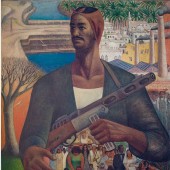Hamed Ewais
An oversized soldier looms protectively over a group of Egyptian people engaged in a variety of daily activities: a wedding, a mother nursing her baby, children drawing and riding bikes, a couple lovingly embracing. In the distance a plantation, a village, a factory and a group of factory workers are depicted. Painted in the crippling aftermath of the 1967 Arab-Israeli War, The Protector of Life offers an image of strength, but also caution: the soldier securely holds his rifle in one hand, whereas his other tenderly shields and protects the people going about their daily lives. Beyond the cradle of the soldier’s enlarged hand, to the right, lies a deserted landscape and a barren tree, suggestive of Egypt’s loss of the Sinai Peninsula during the 1967 war. This staggering defeat crushed the hopefulness espoused by President Gamal Abdel Nasser’s Pan Arabist vision and led to a period of self-criticality throughout the region.
Influenced by key figures of Mexican muralism such as Diego Rivera and David Alfaro Siqueiros, Ewais chose to work in an aesthetic style that reflected his socialist political leanings. A key moment for the artist came during Ewais’ visit to the 1952 Venice Biennale, where he encountered Italian social realist painters. As one of Egypt’s leading social realist painters, Ewais highlighted the plight of the country’s working class and was a proponent of Nasser’s Pan Arab movement. Ewais graduated from the Cairo’s School of Fine Arts in 1944 where he trained under Youssef el-Afifi, later he continued his studies at the Royal Academy of Fine Arts of San Fernando in Madrid, returning to teach at the Faculty of Fine Arts in Alexandria. Ewais was of the founders of the Group of Modern Art in 1947 along with several artists among them Gazbia Sirry and Zeinab Abdel Hamid (both represented in this exhibition). In 1956, he was awarded the Guggenheim International Prize.تصور "حماة الحياة" جندياً عملاقاً يشمخ باقتدار وسط اللوحة محتضناً مجموعة من المصريين أثناء مزاولة حياتهم اليومية: عروسان في موكب زفاف، أم تعتني بطفلها، أطفال يرسمون ويركبون الدراجات الهوائية، حبيبان يتناجيان. وتلوح في خلفية اللوحة حقل وقرية ومصنع ومجموعة من العمال. رسم عويس هذه اللوحة في أعقاب هزيمة عام 1967، وهي تجسد في مضمونها القوة والحذر في آن معاً: حيث يمسك الجندي بندقيته بإحكام بيد واحدة، بينما يحمي بيده الأخرى الناس الذين يمارسون حياتهم اليومية. وخلف يد الجندي العملاقة إلى اليمين، يتراءى مشهد صحراوي مع شجرة عارية الأغصان يرمزان لخسارة شبه جزيرة سيناء خلال حرب 1967. كان وقع هذه الهزيمة قاسياً على الشعب المصري، حيث حطمت روح الأمل التي زرعها الزعيم العربي جمال عبد الناصر، وأفضت إلى مرحلة من النقد الذاتي عبر جميع أنحاء المنطقة.
تأثر عويس بكبار رسامي اللوحات الجدارية المكسيكيين أمثال دييجو ريفيرا وديفيد ألفارو سيكويروس، حيث اختار العمل بأسلوب جمالي يعكس ميوله السياسية الاشتراكية. وقد حظي خلال زيارته إلى بينالي البندقية عام 1952 بلقاء العديد من رسامي الواقعية الاجتماعية الإيطاليين. وبصفته أحد أبرز رواد الواقعية الاجتماعية في مصر، سلط عويس الضوء على معاناة الطبقة العاملة في البلاد، وكان مؤيداً للحركة القومية التي قادها جمال عبد الناصر. وتخرج عويس من مدرسة الفنون الجميلة بالقاهرة عام 1944 حيث تدرب على يد يوسف العفيفي. ثم استكمل دراساته لاحقا في الأكاديمية الملكية للفنون الجميلة في سان فرناندو، مدريد، ليعود لاحقاً إلى مصر ليقوم بالتدريس في كلية الفنون الجميلة في جامعة الاسكندرية. كان العويس من مؤسسي "جماعة الفن الحديث" عام 1947 إضافة إلى عدد من الفنانين الآخرين منهم، جاذبية سرّي وزينب عبدالحميد (يتضمن المعرض أعمالاً لكل منهما). وفي عام 1956، حصل على جائزة جوجنهايم الدولية.
Related artists by country
- Ahmed Askalany
- Adam Henein
- Chant Avedissian
- Fathi Afifi
- Fathi Hassan
- George Bahgory
- Ghada Amer
- Huda Lutfi
- Khaled Hafez
- Lara Baladi
- Abdel Hadi El Gazzar
- Ahmed Moustafa
- Raafat Ishak
- Susan Hefuna
- Youssef Nabil
- Gazbia Sirry
- Ragheb Ayad
- Seif Wanly
- Samir Rafi
- Omar El Nagdi
- Hamed Nada
- Kamel Moustafa
- Kareem Lotfy
- Mahmoud Said
- Mohammed Naghi
- Nermine Hammam
- Youssef Kamel
- Hazem Mahdy
- Ayad Al Nimar
- Mohammed Ismail
- Adel El Siwi
- Adham Wanly
- Guirguis Lotfy
- Hussein Bicar
- Inji Efflatoun
- Kamel El Telmesani
- Khaled Zaki
- Moataz Nasr
- Reda Abdelrahman
- Shaaban Zaki
- Effat Naghi
- Farghali Abdel Hafiz
- Mohammed Sabry
- Wael Darwish
- Ahmed Kassem
- Marwa Adel
- Ammar Abo Bakr
- Basim Magdy
- Ganzeer
- Iman Issa
- Mohamed Abou El Naga
- Clea Badaro
- Farida El Gazzar
- Maha Maamoun
- Marguerite Nakhla
- Ramses Younan
- Salah Abdel Kerim
- Yasser Rostom
- Amr Nazeer
- Aya Tarek
- George Hanna Sabbagh
- Nadim Raef
- Tahia Halim
- Hussein Fawzi
- Ahmed Morsi
- Walid Ebeid
- Ezequiel Baroukh
- Saad El Khadem
- Van Leo
- Mamdouh Ammar
- Salah Taher
- Zeinab Abd El Hamid
- Armen Agop
- Wassef Boutros-Ghali
- Menhat Helmy
- Mariam Abdel-Aleem
- Hamed Abdalla
- Alaa Awad
- Ehsan Mokthar
- Fatma Arargi
- Salam Yousry
- Anna Boghighuian
- Gamal El Sagini
- Leila Izzat
- Mahmoud Afifi
- Nadia Mohammed
- Rebab Nemr
- Khadiga Riad
- Abdel Badie Abdel Hay
- Mahrous Abdou
- Mohamed Abla
- Nazek Hamdy
- Atyat El Ahwal
- Nitokriss
- Fahima Amin
- Kawkab Youssef Al Assal
- Etimad El Taraboulsy
- Naeema El Shishini
- Kadria Hussein
- Aida Marini
- Mohamed Elbehairy
- Ezzat Ibrahim
- Ihsan Khalil
- Salam El-Alak
- Zainab Abdo
- Maggy Axisa




